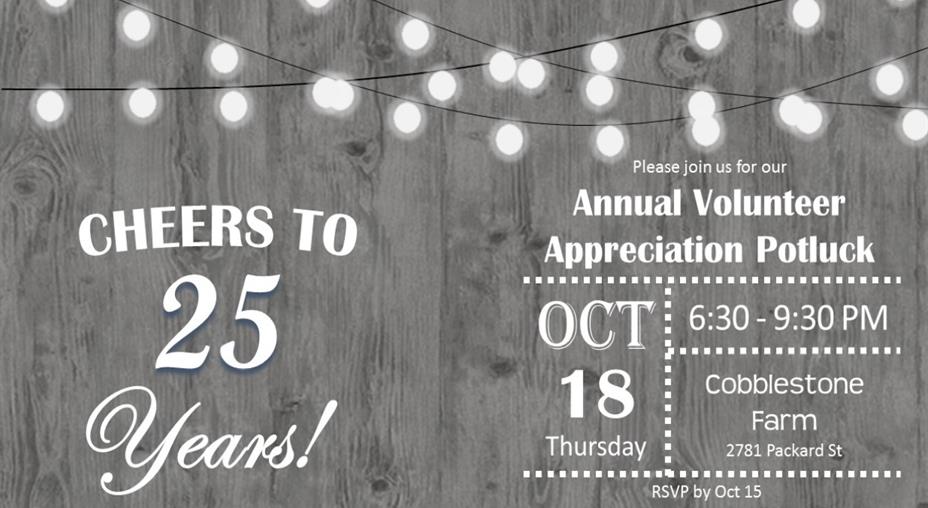Protecting and restoring Ann Arbor's natural areas and fostering an environmental ethic among its citizens.
Volume 23, Number 3
Autumn 2018
Special 25th Anniversary Edition
Park Focus: Braun Nature Area
It's Been 25 Years! Where Are They Now?- Full responses
NAPpenings
Annual Volunteer Appreciation Potluck Invitation
Park Focus: Braun Nature Area
Chris Robey, Conservation Worker
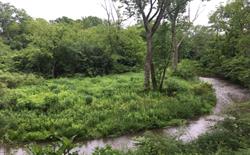
Mallets Creek runs through Braun Nature Area
On a tip from Mike, one of NAP's Stewardship Specialists, I've sought out a bluff he says offers an unparalleled view of Braun Nature Area. True to his word, the bluff overlooks the park where it abuts a gentle bend in Mallett's Creek, Ann Arbor's main stormwater outlet.
Upstream, a doe and her fawn, growing into lanky adolescence but still spotted on its sides, wade neck-deep into the current and make for the opposite bank. Clambering up into the brush, they pause, shaking droplets agleam with sunlight from their russet hides, before moving on.
Edging the stream at times are willow and dogwood thickets. The open spaces between them spill over with prairie species—an array of goldenrod, sedges, bromes and wild rye. Scattered throughout are swatches of wildflowers—fragrant monarda, purple allium like little bottlerocket bursts, cup plants with their huge clasped leaves, and golden Alexanders abound.
Downstream, a red-bellied woodpecker posts itself atop a snag's outstretched arm. It lingers there, sunning and preening. I crouch behind the nearest tree, fumbling with the knobs on a borrowed pair of binoculars.
Below my vantage, the bank drops down to the creek's edge. The frayed edges of buried erosion control netting jut from among a similar mix of prairie and riparian species, all planted there to stabilize the bank after it was shaped and filled in by excavators.
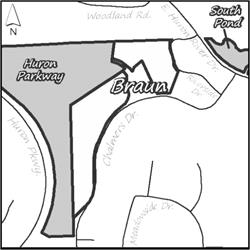 Six years ago this placid bend was a job site, part of the multi-million dollar restoration project that also created the detention basin at Mary Beth Doyle Park and the re-graded streambank at County Farm Park. The bluff I'm crouched on once had been an undercut mat of roots hanging like an overbite over the flashy, silt-laden waters below.
Six years ago this placid bend was a job site, part of the multi-million dollar restoration project that also created the detention basin at Mary Beth Doyle Park and the re-graded streambank at County Farm Park. The bluff I'm crouched on once had been an undercut mat of roots hanging like an overbite over the flashy, silt-laden waters below.
To mitigate this, the bank was completely reconstructed—scooped out and rebuilt with the added support of terraced layers of riprap and packed earth swathed in netting
and a final matting of mulch blankets and seed mix for good measure. The willow and dogwood thickets on the opposite bank all sprouted from live cuttings that had been planted there for additional support.
Thus far, this pairing of revegetation and streambank reinforcement has served its purpose. It does, however, raise the question of whether Braun may properly be called a “natural" area. Braun's recent history of disturbance is compounded by the encroachment of invasives like honeysuckle and reed canary grass, necessitating further interventions to keep them at bay. Some may draw a hard line, while others may find this an arbitrary distinction. I myself wonder: Can't something be beautiful and well-suited to a purpose? Is human involvement in the landscape necessarily an intrusion? While a walk through Braun may not offer ready answers, it may at least offer some perspective.
As a conservation crew member, I have the pleasure of laboring for the benefit of Braun and other natural areas around Ann Arbor. I can see how the crew's labors contribute to the legacy of hands-on stewardship that preceded us and will continue after us.
Early this past spring, we spread seed at Braun soon after conducting a controlled burn there, a full sun prairie mix containing big bluestem, Virginia and Canada wild rye, bottlebrush grass, Monarda, black-eyed susan, and Indian grass. We cast these seeds over bare patches left over from the burn, places where the flames had burned invasive plants' stalks down to the nib, allowing the seeds to have good contact with the soil. With them, we cast our hopes that they would take root. Breaking seed pods between my fingers and breathing deep of their rich scent, I was reminded that this is involvement, the give and take of a sustained conversation with a place.
What's natural or suitable to Braun at this point is hard to tell—along the stream you have something engineered to serve multiple functions, to work both as a drain for the county and as habitat for native species. Then, pushing in from the edges, you have invasives encroaching. Somewhere in the gaps between what we want Braun to be and what it may become if neglected, there are pockets where the land and the life it sustains may properly express itself.
In early summer, I returned to Braun with George, NAP's field biologist, and Janelle, who's interning with him for the summer. We pushed through the waist-high goldenrod and ducked beneath low-hanging catalpa and dogwood branches, seeking out a bend further up. There's no established trail, no clear-set way, only upstream and downstream, nearer and further to useful waymarkers.
We rounded the bend, and came out to a clearer spot near a meander in the creek. There, obscured by tufts of weeds, we found what we were looking for—a turtle nesting mound built with sand used as fill for the streambank restoration project. George and Janelle plucked the weeds then searched for signs of nesting activity, scooping handfuls of sand and probing with their gloved fingers. A few minutes' digging turned up a pair of withered egg shell fragments, cupped in George's hands. Janelle's eyes brightened. “Well, that's something," George said, smiling. A hopeful sign.
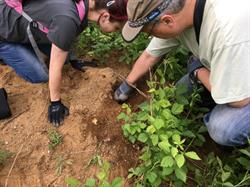
George and Janelle look for signs of turtle nesting.
The labor is a loving act, a small if imperfect repayment for a legacy of carelessness and neglect. With time, we may change that story, and leave a legacy of renewal in its place.
Join us on November 4 for a workday at Braun Nature Area. See the calendar for details.
It's Been 25 Years! Where Are They Now?
One of the great benefits of spending 25 years at NAP is the privilege to have worked with so many fine staff and volunteers over the years - really dedicated, passionate, competent folks. Some of them, especially the volunteers, have stuck around for decades and continue to give NAP the benefit of their many talents. Others, and especially those staff who were in temporary positions here at NAP, used their time here as a springboard into other exciting opportunities or professional positions. It's quite fun for me to look around the audience at someplace like the annual Stewardship Network conference in E. Lansing and count how many former NAP staff are there in attendance, now representing different sister organizations, but still united with NAP in our shared mission to protect and restore native ecosystems. In the past quarter century, NAP has employed nearly 200 staff at various points in their professional careers. It's much harder for me to track the lives of the thousands of volunteers who have touched NAP, but I know they are out there, and I'd love to hear from any of them who would like to share their experience with NAP.
As for the past staff, I remain in contact with many of them. So in anticipation of NAP's 25th anniversary, I reached out to them with a simple request to let us know what they've been up to since they left NAP, and to share any other reflections they have of their time here. The rest of this article is their responses.
Thank you to all the volunteers who have contributed to NAP over the years. And thank you to all the staff, current and former, who have left their mark on NAP. Enjoy these reminiscences. Even if you don't recognize a staff member's name, I think you will be impressed at what NAPpers have gone on to do with their professional lives.
- Dave Borneman, NAP Manager
Irene Frentz – (Intern, 1994, and the first person Dave hired at NAP!): Hard to believe that NAP has already been 25 years in existence -- that means that I was NAP's (first) intern 24 years ago!
As an intern from the School of Natural Resources & Environment at the University of Michigan, I was thrilled to be working with NAP! Remember all the plant inventories? If I remember correctly, the botanists were Beverly Walters, Tim Howard, and Dave Warners - I learned so much from them! I took endless notes ... I loved assisting with water quality monitoring of the Sister Lakes.
I truly enjoyed working with NAP that summer and was very motivated by it. After working as a research associate at the University of Arkansas, and getting my Ph.D. there in Environmental Dynamics, my husband Clint, daughter Erin, and I ended up in Virginia. I have now been a District Resource Specialist with Virginia State Parks for over 12 1/2 years, involved in many things I first did at NAP: prescribed burning, water quality monitoring, inventories, invasive species control, etc. I work with many young people, including staff, AmeriCorps, and volunteers, and I always try to convey my enthusiasm and motivation, as my time with NAP and Dave motivated me!
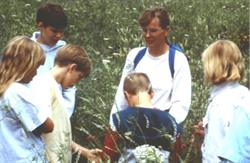 Nature Walk in 1994
Nature Walk in 1994
David Warners (Botanist, 1994-97): Since working for NAP, I finished my Doctoral degree at UM and started a position in the Biology Department of Calvin College. I have been teaching and doing research at Calvin since then (for 20 years now!). Among the classes I have been teaching are Ecology and Evolution, Research Methods, and Plant Taxonomy. My research is mostly in the area of Restoration Ecology, particularly in the Plaster Creek Watershed here in Kent County (http://www.calvin.edu/admin/provost/pcw/)
When I worked for NAP, along with Bev Walters and Tim Howard, I helped generate botanical inventories of natural areas in the AA Parks. While doing this we applied the Floristic Quality Assessment tool so that comparisons could be made among the parks as to the level of their natural quality. This quantitative approach was new back then, but since then it has gained in popularity and I have used it hundreds of times in my work here in West Michigan. I'm currently putting it to good use in a project I'm doing with Dr. Garrett Crow that we call the Emma Cole Project (https://calvin.edu/academics/research-scholarship/historical-field-botany-a-100-year-retrospective-assessment-of-emma-cole-s-grand-rapids-flora-1901). The field botany work I did for NAP also informed and deepened my interests in plant ecology and evolution, interests that have continued to develop since those days. I also have lots of wonderful memories of the relationships I developed with other NAP staff and volunteers, some of whom remain friends to this day.
Bev Walters (Botanist, 1994-2004): As one of the original NAP botanists I was with NAP through its first decade, then moved on to Michigan Natural Features Inventory where I conducted rare plant surveys, and from there to UM Herbarium, where I've enjoyed working with the Michigan Flora Project. NAP gave me the opportunity to gain some local field experience, but more importantly, I learned about the importance of having places where people can connect with nature. I retired this summer from UM and am very much looking forward to sharing more time in nature with my grandchildren.
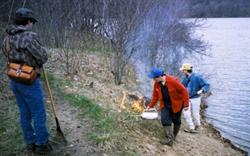
One of NAP's first burns, 1995
Bill Schneider (NAP's 1st “Stewardship and Volunteer Coordinator," 1995): I believe I was Dave's first full-time hire and it was my first job out of grad school. I was at NAP for only about 9 months though I believe it was a very productive period where we began in earnest to address invasive species and conducted the first prescribed burns within the city park system. I met many people who I am still work with closely today.
I left NAP and moved to Wyoming briefly. When my wife and I returned in July 1996 I began Wildtype, a company that operates a native plant nursery and provides ecological services. We are located in Mason, Michigan. Been doing that every single day since.
David Mindell (NAP's 1st “Stewardship Coordinator," 1995-98): I left NAP in May 1998 to start my own business (PlantWise) doing many of the restoration-based things that NAP does. Now, more than 20 years later, I'm still doing the same thing! With a staff of 10, we're able to complete burns and invasives removal, implement numerous native plant landscape projects, and inventory plant and animal species across thousands of acres each year. NAP was instrumental in helping me to read the landscape from a restoration-perspective, learn many management techniques, appreciate the beauty of intact natural areas, and understand the importance of bringing all stakeholders into the decision-making process. I've also had the pleasure of working with many former NAPpers over the years!
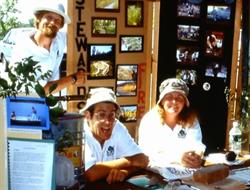
Huron River Day, 1996
Catriona Mortell (NAP's 1st “Volunteer and Outreach Coordinator," 1995-98, 2000): I've been at the University of Michigan's Matthaei Botanical Gardens & Nichols Arboretum for just about 16 years and I am still loving it here. My job with NAP was a significant part of my career development. From the people I worked with - both staff and volunteers - to the work we did in the parks, to my own personal learning, it really was a great experience.
Memories include trying to burn at Dhu Varren during a snow fall (doesn't work!), delivering cookies (nutter butters) after burns and workdays, seed collecting in fall, and the wonderful potluck parties.
Thanks!
Bridget Fahey (Herpetologist, 1996): Great to hear from you. I pulled out my copy of "Along the Huron" and it brought back some memories (although foggy memories -- that was a long time ago!). I've spent the last 20 years working for the U.S. Fish and Wildlife Service in Endangered Species Act implementation in California, Colorado, and now in our Headquarters Office in the greater DC area. My current job includes overseeing the processes to list species as threatened or endangered and to delist them when they are recovered. I love this job!
At NAP, I loved training volunteers to identify all of Michigan's frogs and toads by call. I even got pretty good at my green frog and American toad imitations, and still will bust one out every now and again when the occasion calls for it. I'm also very proud of getting to contribute to “Along the Huron," which is still on my bookshelf!
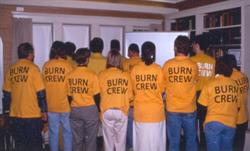 Burn Crew Party, 1997
Burn Crew Party, 1997
Malin Ely (Intern, 1996-97): After leaving NAP, I moved to New Hampshire and have worked at the University of New Hampshire Cooperative Extension for most of the last 20 years. I work with natural resource volunteers, just like I did at NAP, and I continue to be inspired by the contributions of enthusiastic community members. In the last 5 years, I've been working on a project called Nature Groupie, an effort launched with help from The Stewardship Network in Michigan (so NAP connections are still at work!). We connect volunteers to nature-based stewardship and citizen science projects across New England.
I was only with NAP for a year but I have great memories: amazing and committed volunteers (the best!), Dave B. leading the staff in outdoor card games at lunch, worm composting (who knew?), filling in with the burn crew, watching my first woodcock sky dance at Barton Nature Area and wading through a wet meadow somewhere along the Huron River with Joe Pye Weed way over my head.
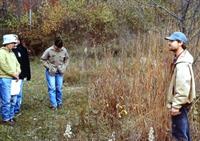
Training Seed Collection Volunteers, 1998
Dea Armstrong (Ornithologist, 1996, 1998-2015): I was a NAPper who left NAP at age 65+, so I did what everyone wants to do and RETIRED! As I told most folks, seems funny to say that because I loved what I did so much that it seemed like I hardly worked at all! Since then I have taken a car trip across country,(yes of course I birded!) and did a BIG YEAR and ended up with 563 species for the lower 48 states. I am still birding regularly and I often travel to enjoy my two grandchildren. Being a grandmother is the best “job" there is. Travel is great too so I plan to go to Borneo next year. I still teach a birding class in April, volunteer at the Bird Lab at University of Michigan and ALWAYS work the polls on election days. I love being retired!
Michelle Barnwell-Boerger (Conservation Worker, 1999-2000): I left NAP in September of 2000 to get married and move to Cincinnati, Ohio. I worked for the City of Mason, Ohio as their Landscape Inspector. I was in charge of overseeing landscaping and bike path projects throughout the city. Brad and I were in Cincinnati for 5 years then moved to West Virginia for 8.5 years then onto Chesapeake, VA for 3 years. We moved back to Cincinnati in 2017. We have 2 boys, Thomas (13) and Ben (11).
Being on the NAP Crew was such a great experience. It was so much fun getting to know Ann Arbor's many parks and working out in them every day. I always came home exhausted with interesting stories to tell. Whether it was a prescribed burn, tagging Canada geese, pulling garlic mustard, removing purple loosestrife, repairing park trails, gathering seeds or wielding a chain saw, I loved every minute of it.
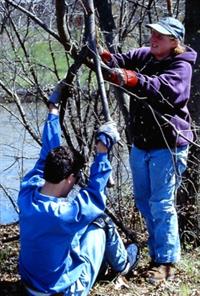
Cutting Buckthorn, 1999
Kee Condict (Stewardship Coordinator, 1999-2002): Has it really been 16 years since I was working alongside my fellow NAPpers, managing natural areas through prescribed burns, invasive species removal and volunteer work days? Since I left in 2002, I ventured down to Nashville, TN to work as a Data Manager for the Division of Natural Heritage for 4 years. They fondly referred to me as a liberal, tree-hugging Yankee from Ann Arbor. Made my way back to the Mitt and worked for the Michigan Department of Natural Resources helping to manage the conservation crew at Island Lake Recreation Area. And after some soul searching, I decided to go back to school and earn my Doctor of Physical Therapy degree. Currently I am working as a PT at the UM Trauma Burn Center where I evaluate, treat and manage patients with physical impairments and try and get them back to their functional baseline, much like we did with Ann Arbor's natural areas. So, in some ways, you could say I've come back home, but just managing the health of a different population now. I'm ever grateful for my time and experience at NAP. I wouldn't have traded it for the world.
David Mifsud (Herpetologist, 2000-13): I continue to run my business, “Herpetological Resource and Management," dedicating my career to the conservation and management of amphibians and reptiles in Michigan. I have also published a Best Management Practices manual focused on amphibians and reptiles and co-authored the Revised Edition of Amphibians and Reptiles of the Great Lakes Region. In addition to my local work, I have kept busy conducting field work and helping with turtle conservation in Vietnam, South Africa, and Madagascar. I credit much of my early professional success to the influence and mentoring of people like Dave Borneman and the opportunities I received while working with NAP, and am forever grateful.
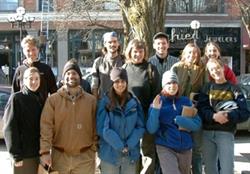
NAP Staff in 2001
Barb Barton (Lepidopterist, 2001-04): Went back to school and got my Master's in Ecology, worked at Michigan Natural Features Inventory for a spell, put out four CDs and wrote two books, continued my wild food foraging and wild ricing, and now work for MDOT as a water quality specialist.
What I remember most about working at NAP was the people. It was the best group of folks I had ever worked with, they were cool, funny, charming, beautiful, inspiring, helpful, and wacky. One fellow brought me a piece of the Great Wall of China from his trip there. Dave Borneman helped me work through finding a dead body in South Pond Nature Area. I could go on. I feel so blessed to know these fine people and to continue to call them my friends.
Dana Wright (Conservation Worker, and Outreach Assistant, 2001-03, 2005-09): After NAP, I went to Legacy Land Conservancy in 2009 as the first person there dedicated to stewardship. In my first year, I launched the volunteer program to help with monitoring responsibilities. We currently monitor 98 properties with the aid of 50 volunteers. I also started the still-active Stewardship Committee which guides staff in decision making around programmatic changes to the Monitoring Program and the Preserve Stewardship Program. Legacy manages 312 acres of preserved land, soon to add another 25 acres.
I see my time with NAP as a springboard into the larger community of ecological restoration. Many relationships I started in my time at NAP continue to be important in my life professionally as well as personally. In looking around at the SE Michigan restoration people I see a lot of NAP influence. I see in other NAP "graduates" a common bond. Even folks that pre-dated me or moved through NAP after, I feel connected to through NAP. Obviously, we can all bond about the upsides and downsides of working with Dave as well! I absolutely love seeing park stewards around town and catching up on their park and other NAPpenings. I learned so much, and while I would never go back, I still highly value my time there.
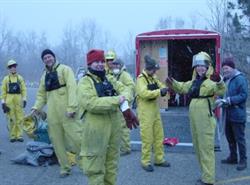
Burn training in the snow, 2002
Eric Ellis (Crew Leader, 2002-04): Since moving on from NAP I have finished graduate school, worked for a non-profit removing dams and restoring habitat in northern Michigan, worked as a regional wildlife biologist and grant writer for a major conservation organization, and managed the natural resources department for the Huron-Clinton Metroparks. I am now managing multi-million dollar restoration projects throughout the Great Lakes basin with the Great Lakes Commission. Among many other things I've burned grasslands, cut trees, built snake hibernacula, culled deer, planted native shrubs, raised money, counted frogs, pulled knapweed, and testified against ridiculous legislation.
My time with NAP was a springboard early in my conservation career where I was given the opportunity to help plan and implement restoration activities and get significant and meaningful experience with prescribed fire, working with the public, species surveying, and invasive species control. I have found myself talking about this experience in job interviews ever since and using the knowledge gained during my everyday work. I also made many lifelong friends who I do not see frequently enough but who are never far from my thoughts. Not surprisingly, every one of them is still employed someplace where they have the opportunity to improve and protect the natural world in the Great Lakes region. That is a testament to the type of person that is drawn to work at NAP and where that experience can lead.
Jason Frenzel (Volunteer and Outreach Coordinator, 2002-11): I'm still in the Ann Arbor area, now at the Huron River Watershed Council, managing volunteers to monitor and improve water quality. With over a decade and a half of volunteer management experience (all thanks to NAP), I'm now the President of the National Association of Volunteer Managers.
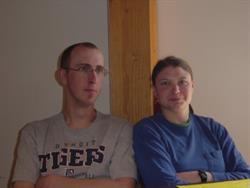
Outreach Coordinators in 2004
Lauren Theodore (Conservation Worker, 2003-04): Since leaving NAP, I got a Master's degree, got married, lived in six states, worked for two federal agencies (NOAA and the USFWS) and two state agencies (Virginia Department of Environmental Protection and North Carolina Division of Coastal Management), had two kids - oh, and I turned 40 (yikes)! I currently work for the U.S. Fish and Wildlife Service Natural Resource Damage Assessment and Restoration Program as a Restoration Biologist. I live in Freeport, ME, which I love and my work takes me all over New England. I think of NAP all the time as my job involves identifying, funding and helping to implement all kinds of natural resource restoration projects (from invasive plant removal to dam removal). And I still keep in touch with many of the folks I worked with at NAP - they are friends for life! Happy 25th Birthday NAP!
Laurel Malvitz (Outreach Assistant, 2003-05): What I'm doing now and what I've done since I left NAP are almost one and the same! I've been working as a Natural Resource Steward for the Michigan Department of Natural Resources, Parks and Recreation Division, Stewardship Unit since fall of 2005. I started and continue to grow the Volunteer Steward program in Southeast Michigan state parks, leading volunteer workdays year-round to combat invasive species and restore high quality ecosystems, and coordinating independent monitoring/surveying projects. I learned so much about ecological restoration and working with volunteers in my years at NAP that have helped me grow and have so many good memories from working at NAP. Highlights include time prescribed burning, pulling garlic mustard in the snow, working with fellow crewmembers, Park Stewards and co-Outreach Coordinator Jason Frenzel, and having to number the Jasons, in order of their or their partners' appearance at NAP (Frenzel, Tallant, Draper, Hill) in order to keep straight who we were telling stories about!!
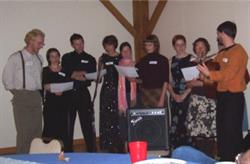
Staff singing at the potluck, 2006
Suzanne Ewing (Conservation Worker, 2006-08): I've been living in Avon Colorado for 10 years. I'm a critical care/search and rescue paramedic for Eagle County. I've been working on a low carbon footprint driving a hail-damaged Volt and taking advantage of Colorado sun with 22 solar panels! I forwarded this email on to Molly Murphy. Together we've gone on about 6 backpacking/hunting trips and skied even more days. NAP mapping, birding and botany skills have come in handy for both of us! Hope all is well!
Matt Demmon (Conservation Worker, 2007-12): Since I left NAP I've done a bunch of things, but most recently spent a long stretch working for PlantWise as their "Director of Native Landscapes". I helped out in all aspects of the business; invasive plants, prescribed fire, and native landscape maintenance, but mostly was designing and installing native landscapes. I've recently branched out on my own and am starting a business that focuses on native landscape design and installation in the Ann Arbor area. The name of the business is Feral Flora.
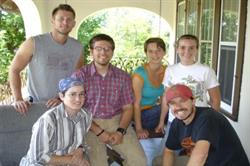
NAP Crew, 2007
Shafkat Kahn (Conservation Worker, 2008): After working at NAP, I went on to get my PhD from the University of Georgia. I did my field work in Costa Rica. I also spent some time in the prairies of northern Florida, where the fire dominated ecosystem put my time with NAP, especially prescribed fire, into clearer perspective! Currently I'm working with Project Dragonfly, Miami University, Ohio where I teach graduate students in conservation and biology. I just taught a course in India, where we were examining the relationship of local people with nature and their conservation practices. During this course too, my time with NAP and seeing how local community support was garnered certainly helped me connect the dots for my US students about community-based conservation in an urban setting in the US.
Steve Parrish (Conservation Worker, 2008-11): Much of what I learned about restoration ecology I learned in the 4 years I worked at NAP. Since I left NAP I've had the good fortune to become the Natural Areas Manager at Matthaei Botanical Gardens and Nichols Arboretum. There, I am carrying on the good work of caring for the land and teaching interns and volunteers to do the same. I have fond memories of intimate lunch conversations, kickball tournaments and perhaps...the fine South Pond Nature Area buckthorn berries.
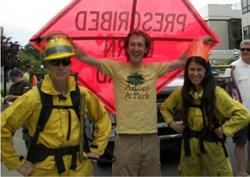
4th of July Parade, 2009
Christine Chessler-Stull (Outreach Assistant, 2010-13): I can't thank NAP enough for the connections and experiences that have shaped my career in environmental education and volunteerism in Ann Arbor. I was an Outreach Assistant at NAP from 2010-2013 and then went on to work as an Outreach Coordinator for Recycle Ann Arbor, 2013-2018. As of this September, I've accepted a position as Volunteer Coordinator for the University of Michigan's Matthaei Botanical Gardens and Nichol's Arboretum. It's been great to stay in the same circles as former NAPpers and volunteers over the years.
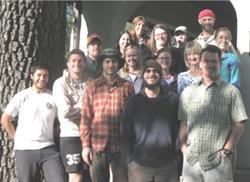
NAP Staff in 2011
Rachel Maranto (Conservation Worker, 2012-13): I was on the NAP field crew for the 2012 and 2013 seasons. Since 2014 I have been working for the Michigan Nature Association, first as the Regional Stewardship Organizer for our southeast Michigan sanctuaries, and now as the Stewardship Coordinator for staff and sanctuaries across the Lower Peninsula. MNA is a statewide land conservancy dedicated to protecting Michigan's endangered species and the habitats they need to survive.
Yousef Rabhi (Outreach Assistant, 2012-14): NAP has been a huge part of my life and professional development! After my 2 ½ years on the Outreach team I started working at Matthaei Botanical Gardens and Nichols Arboretum as the volunteer coordinator, a job which I held for nearly 3 years before being elected to the state legislature as the State Representative for the 53rd district. My time with the NAP Outreach team helped me to hone my people skills and build my public speaking. I also gained new and valuable knowledge about ecosystem management and new techniques of communicating to others about nature and natural systems. This has been invaluable as one of the only state legislators with an environmental science professional background.
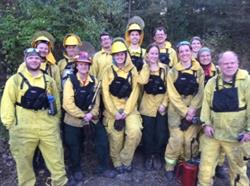
Burn Crew in 2013
Kegan Schildberg (Conservation Worker, 2013-14): Since leaving NAP in the spring of 2014 I have worked as Oakland County Parks & Rec.'s Natural Area Stewardship Manager (or whatever we are calling my position this month). My favorite NAP memory would have to be that of my first day on the job, the infamous 14-hour Bird Hills burn of 2013. Probably the single hardest first day on the job in my life, but a memory that will last a lifetime. A burn so hot we spent the next day mopping up chimney trees.
Patrick Terry (Conservation Worker and Herpetologist, 2014-17): Since leaving NAP, I have taken a job as a biologist for the US Air Force in Arizona. The main objective of my job is to monitor the Sonoran pronghorn, which is federally endangered and happens to graze on an active gunnery range. So every day my team and I drive several miles into the Sonoran Desert to survey for pronghorn and close the targets they are grazing near. I occasionally get the chance to help out the USFWS with their Sonoran pronghorn capture-release program in addition to my everyday work. This is always a rare treat because I get to work hands-on with the pronghorn and I can't help but be impressed that I am touching an animal that runs at 70 mph. All in all, I am very happy with this work. I feel that it is exactly what a biologist job should be in the modern world, and I will always be grateful to NAP for giving me the experience to be here.
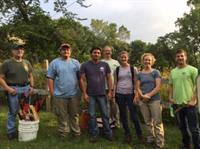
Setting up for a workday, 2015
Catie Wytychak (Outreach Assistant, 2015): Congrats on 25 years of hard and successful work. Since I left NAP I have been working at the Washtenaw County Water Resources Commissioner's office in the rain garden program. I manage the maintenance, volunteer and education work in the public rain gardens within Ann Arbor. I also teach in schools through the county about rain gardens, stormwater management and water quality. With students, we build rain gardens in schoolyards to create a teaching tool, improve stormwater management and introduce native habitats.
While working for NAP, I learned how to identify and prioritize the maintenance needs of a public natural area which is a skill I now use every day. I also learned the importance of involving folks in volunteer, research and educational projects by building strong relationships.
Logan Nevins (Outreach Assistant, 2015-16): Hope all is well with you and the rest of the NAP crew. I still get excited and now a little jealous every time I see the burn texts and pictures during burn season. Thank you for sending this out. I really enjoyed my year and a half at NAP and that time really helped me grow as a volunteer coordinator and to build great relationships with volunteers. I now get to travel the country meeting Ducks Unlimited volunteers who are passionate and driven for a cause much like the NAP volunteers in Ann Arbor.
Since leaving NAP in July 2016 I have been working at Ducks Unlimited National Headquarters in Memphis, TN as the Youth & Education Coordinator. I work with our high school and university chapter volunteers raising money for wetlands conservation and implement new youth programs. I also worked with our senior volunteers to launch Ducks Unlimited's first ever scholarship program for high school seniors. The main project I work on is our University Leadership Summit, Third Term which brings nearly 200 of our top collegiate volunteers from across the country to our headquarters for a leadership conference to grow their fundraising efforts and reward them on all their accomplishments.
Ducks Unlimited and NAP both have a mission to restore and protect landscapes whether it's natural areas or wetlands. They both also have very passionate and dedicated volunteers who work tirelessly to ensure future generations have an opportunity to enjoy natural spaces. While at NAP I was able to learn a lot about how important it is to build a relationship with your volunteers. Now I get to travel the country meeting DU volunteers who, like their counterparts at NAP, work hard at work worth doing.
Congratulations to NAP for fostering an environmental ethic amongst the citizens of Ann Arbor. I am very proud to have been a part of that history and I look forward to the day I can visit Ann Arbor and see how the staff and volunteers have improved the natural areas I once worked in.
Thank you, Dave, for this opportunity. Congrats to you and everyone that has been involved with NAP for accomplishing so much in the last 25 year. I hope you and everyone are doing well and next time I am in Ann Arbor I will be sure to stop by and say hello.
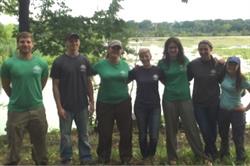
Staff members in 2016
Dan Engel (Conservation Crew Leader, 2015-16): After my time at NAP, I spent a short summer volunteering for the Huron River Watershed Council doing stream surveys (very fun!). Now I work as a contract biologist for the US Geological Survey - Great Lakes Science Center. My work has focused on Phragmites control efforts. I have contributed to two lines of innovative research: 1) how symbiotic relationships with microbes may facilitate Phragmites' competitive abilities, and 2) gene silencing techniques (not to be confused with gene modification) that could limit certain traits (e.g., photosynthetic capacity) that influence Phragmites' competitiveness. Now my role has shifted to developing and maintaining a program called the Phragmites Adaptive Management Framework which has been created in response to land managers' calls for a science-based decision-support tool that can guide their Phragmites management programs.
I have many fond memories of working at NAP! My favorites all involve fire or some remote corner of a natural area away from the hustle and bustle of the city. The field skills (e.g., native plant identification, invasive species control, safety) that I acquired have been invaluable in my current job, and I am very grateful for everything I learned from my NAP mentors. An unexpected lesson I learned was the value of volunteers to a habitat restoration program - without public support and active involvement, restoration projects are not able to achieve their full potential. In fact, I enjoyed my time with NAP enough that I became a breeding bird survey volunteer after I moved on to another position; I just couldn't stay away! Lastly, the relationships that I developed in my short 9+ months at NAP have endured, and I continue to stay in touch with many past and current NAP staff.
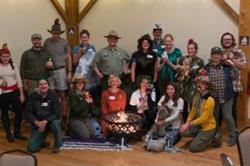
Staff in costumes at the potluck, 2017
Katie Carlisle (Outreach Assistant, 2016-18): Since leaving NAP, I have been working for Washtenaw County Parks and Recreation's Natural Areas Preservation Program as a Stewardship Coordinator. Working with NAP was my introduction to land preservation and management in addition to working with volunteers. I am grateful for these experiences as they have started the path I'm on today.
Do you have a memory of NAP you would like to share? Email us at [email protected]!
NAPpenings
Thank you!
Many thanks to the groups who volunteered with NAP recently. We could not make such a difference without you!
Ann Arbor Academy
Ann Arbor STEAM
Ann Arbor Open School
Community High School
Cub Scout Pack 131
Doris Duke Scholars
Gross Electric
Huron High School Biology Classes
Ypsilanti Free Methodist Church
The Stewardship Network
The Science Practice, and Art of Restoring Native Ecosystems Conference
January 11-12, 2019
The Stewardship Network presents this annual conference at the Kellogg Conference Center at Michigan State University in East Lansing. Presenters cover a wide range of topics including environmental justice, watershed conservation, and much more! See www.stewardshipnetwork.org to register or for more information.
Praise for NAP
Despite the intense heat of the day, this workday was impressive. The students had a great time and felt very accomplished. We enjoy our workdays with you and your crew and we credit your commitment to the trail for making the restoration a reality. Let us keep this educational partnership between our organizations going! - Denise Chacon Lontin, Ann Arbor Open School (workday at West Park)
Everything about this workday was great. I heard several of the parents comment that they routinely use the woods so they are happy that they can help take care of it. - Stephanie Hunter (workday at Dicken Woods Nature Area)
You're Invited!
